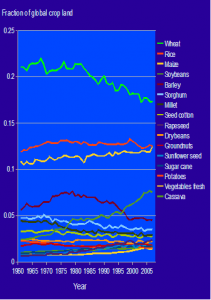- Get your eco-coffee here. Where? Dominican Republic!
Nibbles: Early diet, Rice, Veggies, Barley, Research, Taiwan, Coffee trade
- Early Peruvians didn’t brush their teeth. On the plus side, they had a tasty, varied diet.
- Mangrove rice farming in West Africa: The Book.
- “Could it be that vegetables are the new meat?“
- Wild relative rescues barleys threatened by Russian pests.
- Gates supports McKnight supports poor farmers.
- Vavilov does Formosa.
- Ethiopian Commodity Exchange gets to grips with coffee. Starbucks unavailable for comment.
Over-utilized crops?
Thinking about biofortification, I imagined a world that relies on fewer and fewer over-utilized crops. When will 95% of our food come from two or three of them? Perhaps a maize-arabidobsis hybrid, a cassava wunderroot, and super-rice? Shouldn’t we rather buck that trend and diversify agriculture? That message comes from several corners, like this one: “a food system that is good for us, our communities and the planet is small-scale, diversified agriculture.”
 I checked ((Abused if you like, there is a long tradition to do so.)) the FAO statistics to see how bad things are going. How quickly are we un-diversifying agriculture? If you consider the fraction of crop land planted to different crops, it appears that — at the global scale — the opposite of what I expected is happening. Between 1961 and 2007, maize and soybean area went up, but that was countered by the decline in the area planted with wheat and barley. ((The graph shows the major crops (crop groups) of the 157 that FAO tallies.)) It is a story of both winners and losers, and — overall — an increase in diversity.
I checked ((Abused if you like, there is a long tradition to do so.)) the FAO statistics to see how bad things are going. How quickly are we un-diversifying agriculture? If you consider the fraction of crop land planted to different crops, it appears that — at the global scale — the opposite of what I expected is happening. Between 1961 and 2007, maize and soybean area went up, but that was countered by the decline in the area planted with wheat and barley. ((The graph shows the major crops (crop groups) of the 157 that FAO tallies.)) It is a story of both winners and losers, and — overall — an increase in diversity.
Global crop diversity, expressed as the relative amount of land planted to different crops, did not change much between 1961 and 1980, but is has increased since. Between 1980 and 2007, the Shannon index of diversity went up from 3.14 to 3.34.
Do tell me why I am wrong. Is it a matter of scale? Global level diversification of crops while these crops are increasingly geographically concentrated? Could be. Is the diversity index too sensitive to the relative decline in wheat? Perhaps. Or are we really in a phase of (re-) diversification, at least in terms of the relative amount of land planted to different crop species? ((The same might be true for within-crop diversity, for some crops, but that’s another story.)) I cannot dismiss that possibility. For example, I have heard several people speak about on-going diversification (away from rice) in India and China. Has anyone looked at this, and related global consumption patterns, in detail?
Gourmet agrobiodiversity
Remember the cacao trifecta from a couple of days ago? Well, the run continues! We heard about this from the horse’s mouth some time ago, of course. But well worth repeating.
Nibbles: Wikiforéts, Super-rape, Gut microbiome, Soybeans, Golf courses, Chestnuts, Rice, Yeast
- Wiki for African forest information. Go, make it multilingual, fill in the gaps, use it.
- Canola (rape) desalinates, gives fuel and enriched fodder. Jeremy comments: “I’m a tad skeptical.”
- Diversity of intestinal flora good for your figure. Or the other way around.
- Edamame bean comes to Britain. Why, one wonders.
- Golf courses good for salamanders. I wonder if anyone’s looked at how many CWRs they support.
- Chestnuts roasting on an open fire.
- Rice domestication unpacked.
- More extreme beer. Oh, and the phylogeny of yeast.